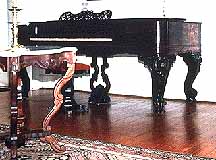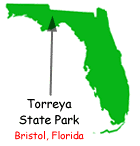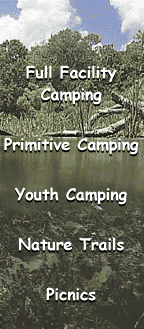
Reservations for
Florida State
Parks are now
made through
Reserve America,
toll free, at
1-800-326-3521
|
TORREYA STATE PARK
 The high bluffs overlooking the Apalachicola River make Torreya State Park
one of Florida's most scenic. Rising more than 150 feet above the river,
the bluffs have been shaped and divided by deep ravines that have been eroded
by streams throughout the centuries. The high bluffs overlooking the Apalachicola River make Torreya State Park
one of Florida's most scenic. Rising more than 150 feet above the river,
the bluffs have been shaped and divided by deep ravines that have been eroded
by streams throughout the centuries.
PLANT & ANIMAL LIFE
The park is named for a species of rare Torreya tree that occurs only on
the bluffs along the Apalachicola River. This once plentiful tree was nearly
destroyed by disease in the early 1960s and may be doomed to extinction.
Other rare plants found in the park include the Florida yew tree and the
U.S. Champion winged elm. The forests of the park include river swamps,
hardwood hammocks and high pinelands. Each community contains a different
set of trees, shrubs and wildflowers which offer variety during each season
of the year. The bluffs and ravines are forested by many hardwood trees
that commonly occur in the Appalachian Mountains of Georgia. These hardwoods
provide the finest display of fall color found in Florida. Over 100 species
of unique and colorful birds may be seen throughout the area. An
array of animals commonly found in the park include deer, beaver, bobcat,
grey fox and the unusual Barbours map turtle.
HISTORY
Animals were not the only inhabitants known to exist in the area over the
centuries. A number of Indian sites have been discovered here by archaeologists.
During the first Seminole Indian War in 1818, General Andrew Jackson crossed
the river here with his army.
In 1828, when Florida became
a U.S. Territory, the first government road across north Florida met the
river here in the park. Throughout the 1800s, the Apalachicola River was
an important interstate highway. More than 200 steamboats traveled the
river during the great trading era, 1840-1910.
During the Civil War, this
important route was protected by a six cannon battery. ŒLocated on
a bluff, the battery was in place to prevent Union gun boats from passing.
The remains of the gun pit can be seen along the bluff trail.
The Gregory House, built in 1849
by Planter Jason Gregory, stood across the river from the park at Ocheesee
Landing. Gregory's plantation prospered until the beginning of the Civil
War and the abolition of slavery. In 1935, the house was dismantled and
moved to its present location in the park by the Civilian Conservation Corps,
which was developing the park.
ACTIVITIES
The natural beauty of the park can best be enjoyed along
one of the nature trails. The Apalachicola River Bluffs Trail, a National
Recreational Trail, offers a view of the river, Confederate gun pits, bluffs
and hardwood forests. The Weeping Ridge Trail provides a healthy and pleasant
walk to one of the park's deep ravines. A seven-mile loop hiking trail meanders
through the park, exposing the hiker to virtually all the park's natural
features.
Recreational activities available
in the park include one of the state's most peaceful and scenic campgrounds,
with two primitive campsites located along the hiking trail for registered
hikers.
A picnic area with covered
shelters is provided.
Ranger-guided
tours of the restored Gregory House are available daily. Included in the
tour are stories of early plantation life along the river.

Torreya State Park is located off S.R. 12. on C.R. 1641, 13 miles north of Bristol.
For more information, contact:
Torreya State Park
Route 2, Box 70
Bristol, Florida 32321
(850) 643-2674.
View Larger Map
|
|




 The high bluffs overlooking the Apalachicola River make Torreya State Park
one of Florida's most scenic. Rising more than 150 feet above the river,
the bluffs have been shaped and divided by deep ravines that have been eroded
by streams throughout the centuries.
The high bluffs overlooking the Apalachicola River make Torreya State Park
one of Florida's most scenic. Rising more than 150 feet above the river,
the bluffs have been shaped and divided by deep ravines that have been eroded
by streams throughout the centuries.
